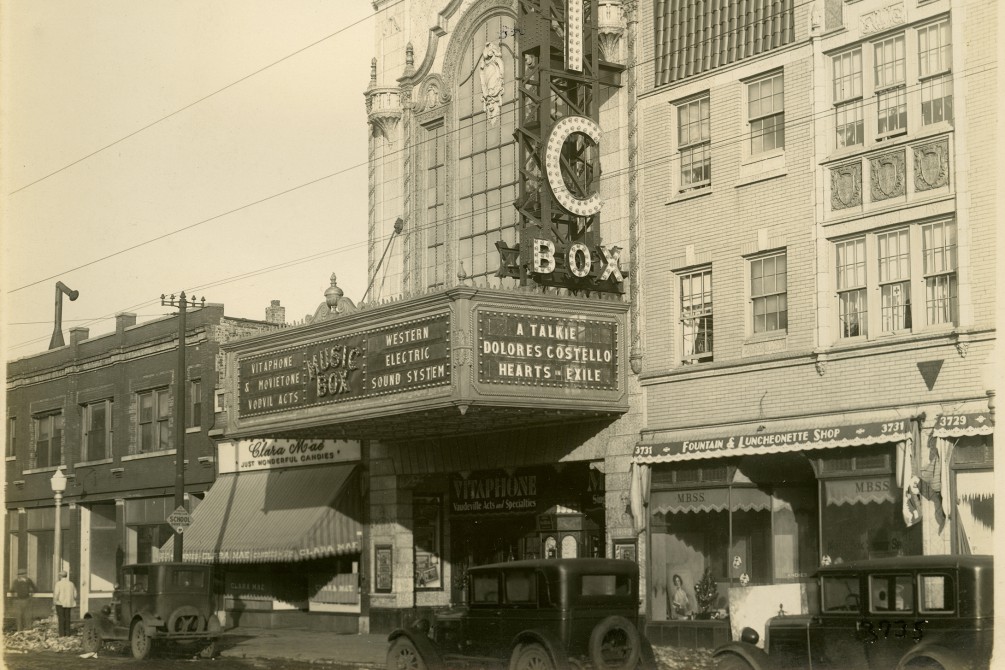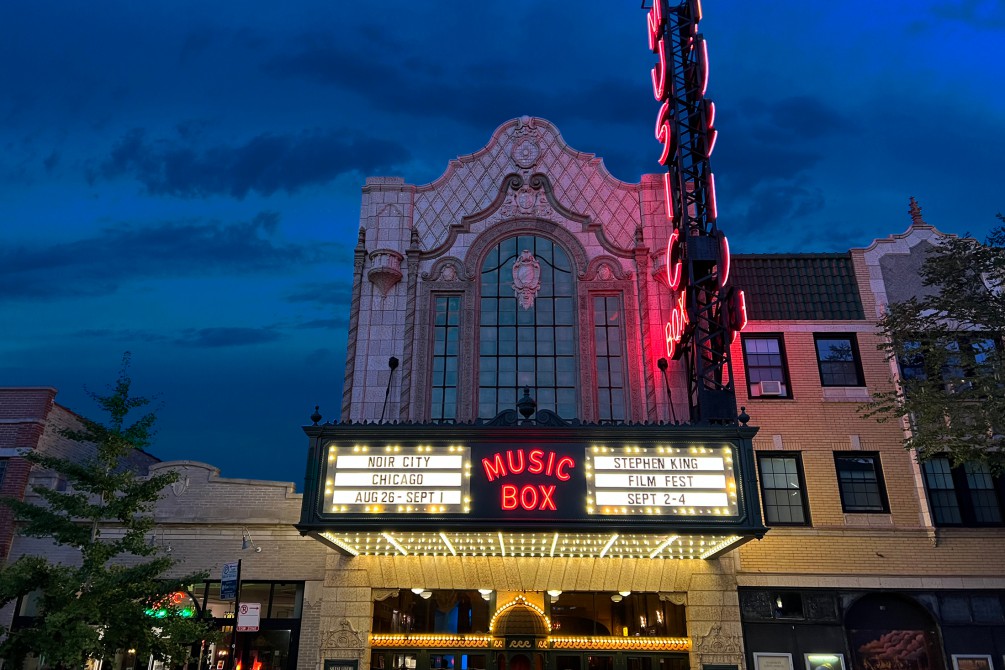Opened 1929, the Music Box Theatre retains its original architecture and design. With a dark blue ceiling, “twinkling stars” and moving cloud formations suggesting a night sky, and walls and towers suggesting an Italian courtyard, patrons are made to feel as if they are watching a film in an open-air Tuscan palazzo.
The Music Box Theatre opened on August 22, 1929, a time when the movie palaces in downtown Chicago each had seating capacities of around 3,000 people. The Music Box, which sat 700, was considered an elaborate little brother to those theatres. Theatre Architecture magazine noted in 1929 that the theatre “represents the smaller, though charming and well equipped, sound picture theatre which is rapidly taking the place of the ‘deluxe’ palace.”
The Building
The theatre was built for a cost of $110,000. The entire building, which also included nine storefronts and 32 apartments, cost $260,000. The building was designed by Louis I. Simon, a local architect who studied architecture at the Armor Institute in Chicago. The building was erected by The Southport Avenue Businessmen’s Association and operated by Lasker and Sons, who operated several smaller neighborhood houses in Chicago.
A Period of Innovation
The design of the Music Box was indicative of the growth of the motion picture. The grand movie palaces that preceded it were multiple-use facilities with stage and film presentation capabilities. The Music Box had no stage and, therefore, could only be a film presentation house. When the theatre was built, sound films were a new technology, and the plans included both an orchestra pit and organ chambers in case sound films failed and silent film accompaniment was needed.
Architectural Style
As Chicago Tribune architectural critic Paul Gapp wrote (Arts and Books, July 31, 1983), "The architectural style is an eclectic melange of Italian, Spanish and Pardon-My-Fantasy put together with passion." The actual style is called “atmospheric”. The dark blue, cove-lit ceiling with “twinkling stars” and moving cloud formations suggests a night sky. The plaster ornamentation of the side walls, round towers, faux-marble loggia and ogee-arched organ chambers are, by Hollywood standards, reminiscent of the walls surrounding an Italian courtyard. Overall the effect is to make the patron feel that they are watching a film in an open air palazzo.
Restoration and Rebirth
Between 1977 and 1983, the Music Box was used sporadically for Spanish language films, porno films and lastly, Arabic language films. In 1983, management reopened the theater with a format of double feature revival and repertory films. Eventually, foreign films were reinstated, and independent and cult films were added to the roster. The Music Box Theatre now presents a yearly average of 300 films.
Part of the re-birth included adding a theatre organ, which is played for weekend intermissions, monthly silent films, holiday sing alongs and special presentations. A large custom electronic organ was installed with the speakers placed in the chambers originally designed for pipes. The irony is that the Music Box is the only theatre in the Chicago area presenting silent films with organ accompaniment on a regular basis, and it began in 1929 playing only sound films.
In 1991, management decided to add a second screen. Rather than split the main theater in two, a small theater was built in an existing storefront adjacent to the lobby. The ambiance of the theatre was designed to echo the architecture of the main auditorium. The feeling is still atmospheric but because of the 13-foot ceiling, the feel is that of sitting under a garden trellis with stars in the night sky beyond.
Current Operations
For over twenty years, the Music Box Theatre has been Chicago’s leading venue for independent and foreign films, boasting the largest full-time theater space in the city. The Theatre is independently owned and operated. Its sister company, Music Box Films, is dedicated to curating a diverse repertoire of films from around the world and distributing them throughout the US. Music Box Theatre and Music Box Films both engage audiences with exciting alternatives to mainstream entertainment.


